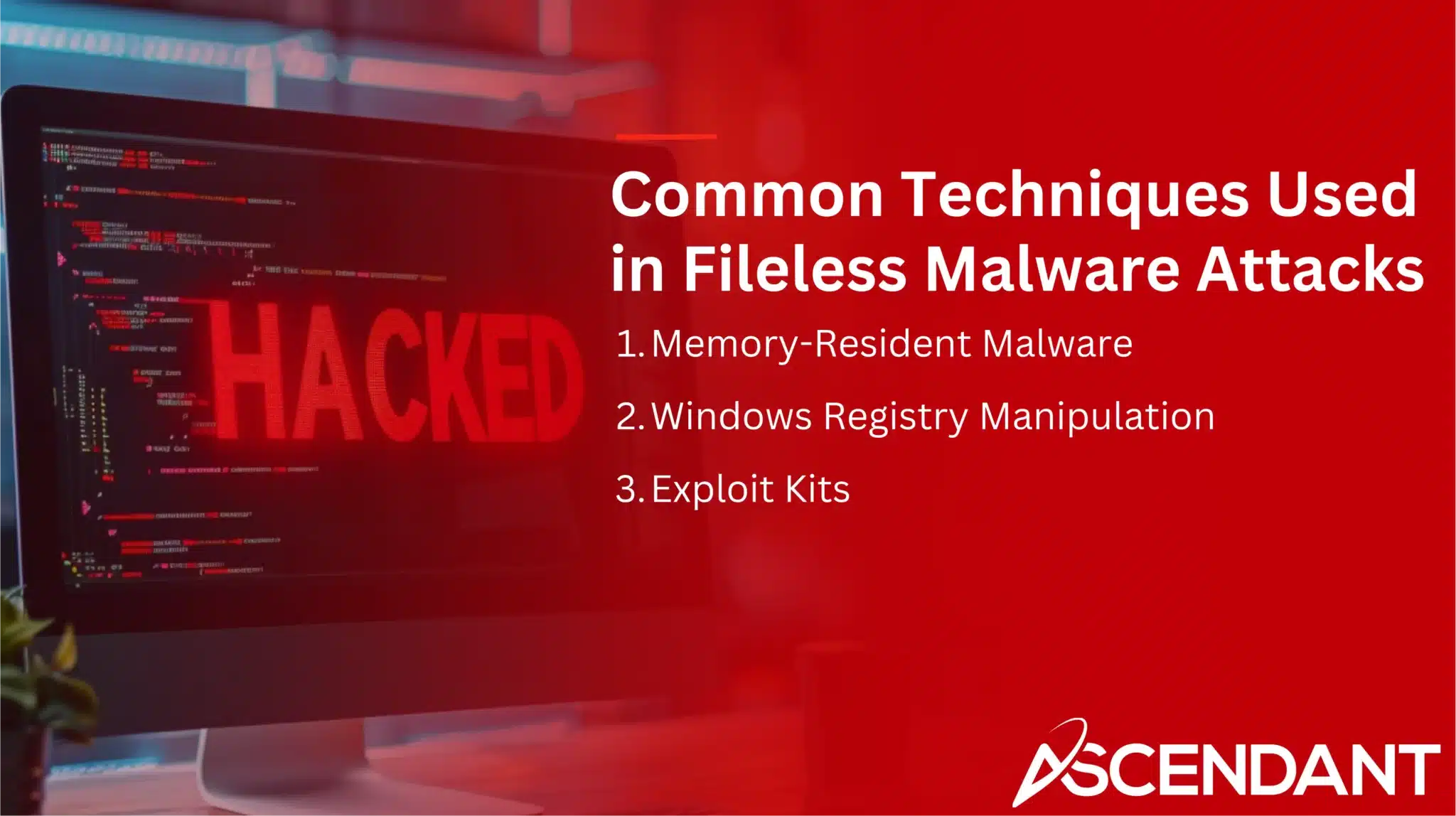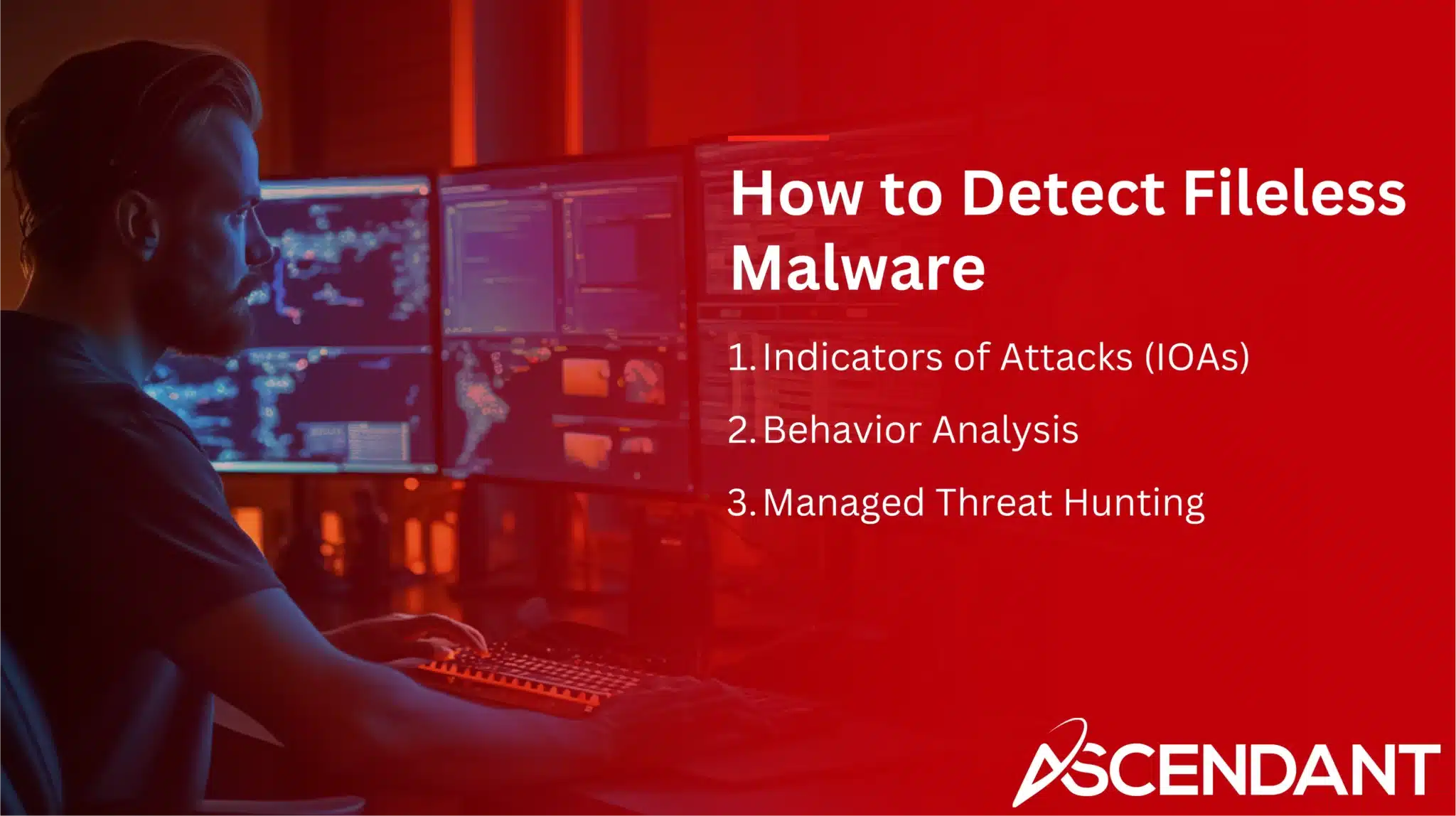Fileless malware is a type of attack that operates directly in memory, bypassing the hard drive to avoid detection. This makes it elusive to traditional antivirus programs that rely on file scanning. In this guide, we explain what fileless malware is, how it works, and what can be done to detect and prevent these sophisticated attacks.
In This Article:
- Understanding Fileless Malware
- Common Techniques Used in Fileless Malware Attacks
- Stages of a Fileless Malware Attack
- Examples of Fileless Malware Attacks
- How to Detect Fileless Malware
- Preventing Fileless Malware Attacks
- The Challenge for Enterprises and Vendors
- SentinelOne’s Approach to Fileless Malware
- Case Study: Detecting Fileless Malware in Action
Key Takeaways
- Fileless malware operates in memory without leaving traces on the hard drive, using legitimate system tools to evade traditional security measures.
- Common techniques for fileless malware attacks include memory-resident malware, Windows registry manipulation, and exploit kits, which complicate detection and persistence.
- Effective detection and prevention strategies against fileless malware include behavior analysis, monitoring native tools, and ongoing employee cybersecurity awareness training.
Understanding Fileless Malware
Fileless malware is a type of malicious code that functions exclusively in the RAM of a computer without leaving any evidence on the hard drive. In contrast to conventional malware, which depends on executable files, fileless malware leverages built-in system tools and protocols for its nefarious purposes. By doing so, it can slip past standard antivirus systems that look for familiar file signatures. Since it operates directly within memory, fileless malware is capable of evading both application whitelisting defenses and sandboxing techniques, making it an especially potent weapon in cyberattacks.
Due to its elusive behavior, fileless malware presents substantial obstacles to customary security measures. Its ability to operate independently from downloadable files means it leaves behind very little traceable activity, rendering traditional detection methods insufficient as they typically search for physical files left by infections.
Because this kind of threat makes use of native system utilities and existing software processes to mask itself effectively—carrying out unauthorized actions while remaining unseen—it requires more sophisticated methods of detection if such threats are going to be identified successfully and mitigated against before causing harm.
Common Techniques Used in Fileless Malware Attacks
Fileless malware attacks employ various sophisticated techniques to execute and persist within systems. These techniques often exploit vulnerabilities in widely-used software, such as Microsoft Office and PDF readers, to execute malicious code. Leveraging legitimate tools present on the system enables fileless malware to perform attacks while avoiding traditional malware signatures.
The primary categories of these attacks include memory-resident malware, Windows registry manipulation, and exploit kits, each with its unique methods of operation and evasion.
Memory-Resident Malware
Fileless malware that remains in a system’s memory is known as memory-resident malware. It lodges its malicious code within the RAM and often does not activate until certain conditions are met. Common tactics include directly inserting code into the system’s memory, employing native scripting like macros, and taking control of crucial system utilities such as PowerShell to inject harmful code alongside legitimate programs, which can hinder detection.
Due to its elusive characteristics, this type of fileless malware poses significant challenges for conventional security tools to identify effectively. Its operation confined to memory coupled with sophisticated concealment strategies enables it to slip past traditional antivirus defenses undetected.
The emergence of these attacks underscores the importance of more advanced security solutions capable of scrutinizing and assessing activities within system memory in order to spot and counteract these types of threats proficiently.
Windows Registry Manipulation
Fileless malware often manipulates the Windows Registry to maintain persistence on an infected system. By embedding malicious code within the registry, it can execute during system startup without creating traditional files, making it difficult for antivirus software to detect.
Malware like Poweliks and Kovter use sophisticated registry manipulation techniques to evade detection and ensure their persistence even after system reboots.
Exploit Kits
Exploit kits consist of an assortment of exploits targeting different vulnerabilities and simplify the process by automating exploitation, thus enabling fileless attacks. Equipped with a management console, these kits scan for system weaknesses and then execute particular exploits as needed.
These exploit kits frequently focus on exploiting flaws in software such as Flash, Java, and web browsers to carry out code injection attacks directly into memory. By utilizing exploit kits, attackers can amplify the reach of their fileless assaults by taking advantage of software vulnerabilities to introduce their malicious payloads without relying on conventional files.
Stages of a Fileless Malware Attack
Fileless malware attacks usually unfold in multiple phases, starting with gaining initial access to a system. Subsequent stages involve the execution of code and establishing mechanisms for persistence, culminating in reaching their final objectives. This sequence underscores both the meticulous design and advanced tactics deployed in fileless attacks, specifically crafted to elude detection while securing prolonged entry into targeted systems.
Initial Access
During the early phase of a fileless malware attack, attackers typically gain entry by distributing the harmful payload via phishing emails that feature dangerous links or attachments designed to implant malicious code. These perpetrators frequently resort to social engineering strategies to deceive individuals into engaging with deceptive links or downloading malignant updates from websites that have been tampered with.
At this critical juncture, exploit kits are instrumental as they utilize flaws within software programs to achieve deep infiltration into the system being targeted.
Code Execution
After gaining entry, fileless malware launches its payload in the system’s memory by leveraging trusted system utilities like PowerShell. By tapping into the built-in tools and scripting languages of a system, fileless malware can carry out its activities without being spotted by standard security protocols. This stealth is achieved through typical tactics associated with deploying fileless malware that allows for undetected code execution.
Take the Duqu worm as an example. It has the ability to execute commands directly within memory without leaving any residual evidence on the computer’s hard drive.
Persistence Mechanisms
Fileless malware secures enduring entry by using different tactics to persist, including altering system settings and changing registry keys to establish backdoors. By embedding malicious code into the Windows Registry, fileless malware is programmed to run when the system boots up, which helps it evade detection while sustaining its access over time.
Such persistence is vital for ongoing data collection and accomplishing the objectives of the attack.
Examples of Fileless Malware Attacks
Investigating actual instances of fileless malware attacks offers crucial understanding of the strategies and consequences associated with these advanced threats. Significant cases such as the Duqu worm, Poweliks, and Kovter highlight the distinct approaches and difficulties that come with fileless malware.
Duqu Worm
The Duqu worm stands out as a prominent instance of only malware that resides solely in system memory, showcasing the difficulties inherent in identifying it and its effects on systems it infiltrates. By remaining within the confines of the computer’s RAM and eschewing disk usage, Duqu manages to elude detection.
An evolved form known as Duqu 2.0 possesses improved functions for moving across networks, extracting sensitive information, and conducting surveillance activities. These capabilities significantly amplify its capacity to inflict harm.
Poweliks
Poweliks employs a complex technique by manipulating the Windows Registry to conceal its malicious code within it. By eschewing usual file systems and instead inserting the code into the registry, Poweliks can slip past standard antivirus software detection methods. This method guarantees that Poweliks remains persistent on the system, reactivating itself even after the computer is rebooted.
Kovter
Kovter is a variant of fileless ransomware that carries out its operations by running malicious code strictly within the system’s memory, thereby avoiding any trace on the hard drive. This method chiefly relies on executing in-memory to slip past detection systems.
The intricate methods of evasion employed by Kovter present substantial obstacles for conventional security protocols, highlighting the importance of implementing more sophisticated strategies for detecting such threats.
How to Detect Fileless Malware
To detect fileless malware, sophisticated methods surpassing conventional file scanning are necessary. These methods encompass tracking indicators of attack (IOAs), analyzing behavioral patterns, and implementing managed threat hunting to pinpoint and counteract the elusive nature of fileless threats effectively.
Indicators of Attack (IOAs)
Critical in uncovering fileless malware are Indicators of Attack (IOAs), which shed light on the underlying objectives and plans manifesting through certain actions. Such indicators target activities linked to malware, like unusual code execution or horizontal progression, rather than pinpointing particular files.
The crucial function of managed threat hunting is underscored by its ability to identify and counter threats via persistent surveillance.
Behavior Analysis
Analyzing behaviors is essential to identify atypical actions that may indicate the existence of fileless malware. By prioritizing the detection of irregular behavior over conventional file-based identification, this method can proficiently pinpoint activities indicative of fileless attacks.
Providers encounter difficulties when devising systems that avoid causing interruptions in IT processes.
Managed Threat Hunting
Proactive security monitoring through managed threat hunting services is aimed at quickly responding to any anomalous activities. By actively searching for and mitigating possible threats, these services aim to bolster cybersecurity measures, thereby strengthening the general stance on security and boosting confidence in managing new threats that arise.
Preventing Fileless Malware Attacks
To thwart fileless malware attacks, it’s crucial to disrupt their deployment mechanisms at the outset and establish strong security protocols. Essential tactics consist of training in cybersecurity awareness, keeping a vigilant eye on native tools, and ensuring systems are updated frequently.
Cybersecurity Awareness Training
Educating employees through cybersecurity awareness training is essential to understanding the risks associated with fileless malware and identifying tactics used in social engineering. By learning how to spot phishing attempts, employees can greatly reduce the likelihood of falling prey to fileless malware infections.
Consistent training helps staff members improve their ability to detect phishing emails that frequently serve as a vehicle for initiating fileless attacks.
Monitoring Native Tools
It is crucial to keep a close watch on built-in operating system utilities like PowerShell to detect and counteract the actions of fileless malware. Conducting consistent audits of how PowerShell is used could reveal abnormal commands that may signal the presence of fileless malware.
Keeping an eye out for atypical patterns in command executions can assist in spotting possible activities associated with fileless malware.
Regular System Updates
To safeguard the enterprise network from malware intrusions, it is crucial to consistently apply updates and patches to systems. This practice ensures that any security gaps are promptly remediated, thereby diminishing the threat posed by fileless malware through exploiting vulnerabilities.
The Challenge for Enterprises and Vendors
Enterprises and vendors face considerable obstacles in detecting and containing fileless malware, which requires the implementation of sophisticated solutions and strategies to combat these fileless threats effectively.
Enterprise Vulnerabilities
Fileless malware poses considerable difficulties for corporate security measures due to its ability to covertly operate. By manipulating trusted applications and modifying command lines, this type of malware is adept at bypassing conventional antivirus defenses. Attackers engaging in fileless attacks utilize authorized tools, which allows them to infiltrate business systems while avoiding immediate detection.
The subtle nature of these attacks makes it challenging to identify malevolent actions promptly, thereby heightening the threat of sensitive information being stolen or siphoned off undetected.
Vendor Solutions
Security vendors face significant pressure to develop effective solutions against fileless malware. Many attempts to solve the problem are less than ideal, failing to address the unique characteristics and stealthy nature of fileless malware.
There is a critical need for improved solutions that can effectively tackle the complexities introduced by fileless malware.
SentinelOne’s Approach to Fileless Malware
Utilizing a behavior-based detection strategy, SentinelOne is equipped to detect and counteract fileless malware by circumventing conventional file scanning methods. Its ‘StoryLine’ function empowers the tracing of malevolent actions to their origin, maintaining efficacy even in instances where files do not play a role in the onslaught.
When a fileless attack comes to light, SentinelOne has the capability to autonomously defuse the danger and alert administrators without manual interference. This sophisticated approach for identifying and responding to incidents provides robust defense against the threats posed by attacks that leverage fileless malware.
Case Study: Detecting Fileless Malware in Action
When a user engaged with an infected Word document, it triggered a fileless attack that leveraged PowerShell commands to retrieve and run malware straight in the system’s memory.
The behavioral detection capabilities of SentinelOne’s utilities proved successful as they identified the anomalous behavior, traced it to its origin, and successfully mitigated the threat posed by the fileless malware.
Summary
Fileless malware is a complex and difficult problem in cybersecurity and requires advanced detection and mitigation to effectively counter these ghostly threats. Understanding the operational methods, tactics used, and phases involved in fileless attacks is key to building strong defenses. Real world examples such as Duqu worm, Poweliks and Kovter give insight into the impact and complexity of fileless threats.
Detection strategies like monitoring for attack indicators, behavior analysis, and managed threat hunting are key to finding and stopping fileless malware activity. Prevention is also important. Educating staff on cybersecurity awareness, auditing native tools on systems, and ensuring regular updates to keep security levels high against potential vulnerabilities that can lead to infections from this type of malware are all critical components to minimizing exposure risks. Thus, we can see how important it is to come up with innovative solutions like SentinelOne so organizations can take a holistic approach when facing the ever-changing landscape of no-file cyber-attacks.
 Frequently Asked Questions
Frequently Asked Questions
What is fileless malware?
Fileless malware is malicious code that operates solely in a computer’s memory, utilizing legitimate system tools to execute its actions without leaving traditional file traces.
This method increases its stealth, making detection challenging.
How does fileless malware evade traditional antivirus detection?
Fileless malware evades traditional antivirus detection by operating entirely in memory without creating files on disk, which makes it undetectable by conventional antivirus software. It often employs legitimate system tools to conceal its activities, complicating detection efforts.
What are some common techniques used in fileless malware attacks?
Fileless malware attacks commonly utilize memory-resident malware, Windows Registry manipulation, and exploit kits, taking advantage of software vulnerabilities and leveraging legitimate system tools for malicious execution and persistence.
How can organizations detect fileless malware?
By keeping an eye on attack indicators, scrutinizing behavioral patterns for irregular activities, and employing managed threat hunting services, organizations can efficiently uncover fileless malware.
This vigilant strategy boosts their capacity to swiftly spot and counteract these types of threats.
What prevention measures can be taken against fileless malware?
It is essential for the prevention of fileless malware to carry out cybersecurity training that raises awareness among employees. Keeping a vigilant eye on native tools like PowerShell for any abnormal activities and consistently updating and patching systems to address vulnerabilities can help reduce potential risks.
By adopting these preventative strategies, your organization’s protection against emerging security threats can be considerably improved.



